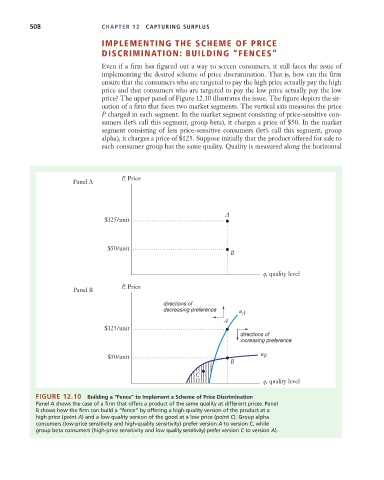Page 534 - Microeconomics, Fourth Edition
P. 534
c12capturingsurplus.qxd 7/22/10 10:41 AM Page 508
508 CHAPTER 12 CAPTURING SURPLUS
IMPLEMENTING THE SCHEME OF PRICE
DISCRIMINATION: BUILDING “FENCES”
Even if a firm has figured out a way to screen consumers, it still faces the issue of
implementing the desired scheme of price discrimination. That is, how can the firm
ensure that the consumers who are targeted to pay the high price actually pay the high
price and that consumers who are targeted to pay the low price actually pay the low
price? The upper panel of Figure 12.10 illustrates the issue. The figure depicts the sit-
uation of a firm that faces two market segments. The vertical axis measures the price
P charged in each segment. In the market segment consisting of price-sensitive con-
sumers (let’s call this segment, group beta), it charges a price of $50. In the market
segment consisting of less price-sensitive consumers (let’s call this segment, group
alpha), it charges a price of $125. Suppose initially that the product offered for sale to
each consumer group has the same quality. Quality is measured along the horizontal
P, Price
Panel A
A
$125/unit
$50/unit
B
q, quality level
P, Price
Panel B
directions of
decreasing preference
u
A
A
$125/unit
directions of
increasing preference
$50/unit u B
B
C
q, quality level
FIGURE 12.10 Building a “Fence” to Implement a Scheme of Price Discrimination
Panel A shows the case of a firm that offers a product of the same quality at different prices. Panel
B shows how the firm can build a “fence” by offering a high-quality version of the product at a
high price (point A) and a low-quality version of the good at a low price (point C). Group alpha
consumers (low-price sensitivity and high-quality sensitivity) prefer version A to version C, while
group beta consumers (high-price sensitivity and low quality sensitivity) prefer version C to version A).

